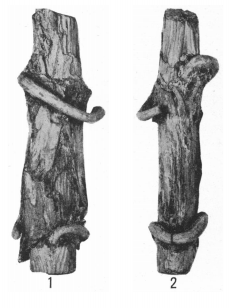Vitoxylon opalinum is a Miocene grapevine from Virgin Valley in northwest #Nevada. Images: Fig. 1-3, Brown, 1942. #NVpaleomonth 1/5
This particular grapevine was fossilized through opalization with dark opal replacing the pith (center of the stem) and the vessels and a lighter shade replacing bark and woody structures. 2/5
Virgin Valley is famous for its opals and the Virgin Valley black fire opal (a mouthful, I know) is #Nevada’s official precious gemstone. The opals form because this part of the world contained abundant trees and plants about 15-20 million years ago that grew around lakes. 3/5
The plant matter-rich lake sediments were buried by silica-rich volcanic tuffs and siliceous fluids eventually partially or wholly replaced the organics. Some of these replacements resulted in matte-brown petrified wood while others formed milky to rainbow-colored opals. 4/5
The area around Virgin Valley is one of my favorite parts of the state. Fantastically remote, beautiful wildlife, interesting rocks and fossils – what more could naturalists ask for? 5/5

 Read on Twitter
Read on Twitter



